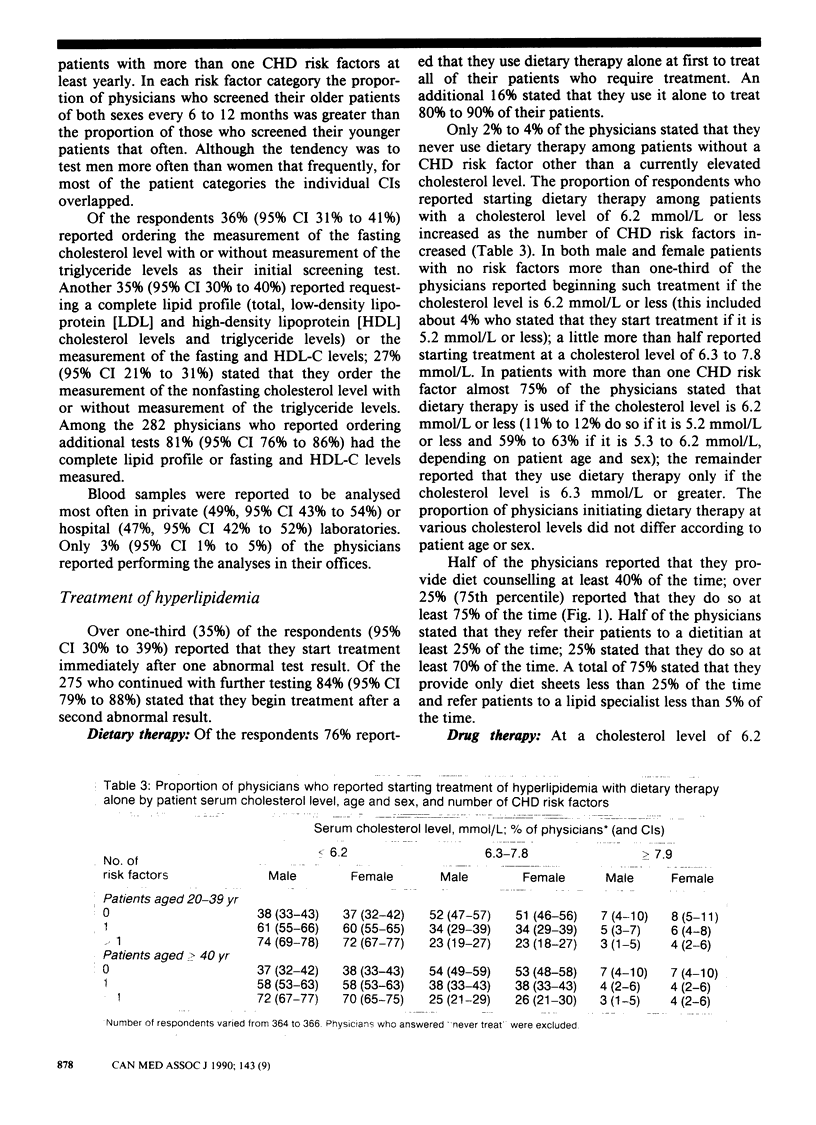Abstract
We surveyed primary care physicians in Canada to determine their current practices regarding the detection and treatment of hyperlipidemia in asymptomatic adults 20 years of age or more and to determine the role of selected patient characteristics (age, sex and the presence of coronary heart disease [CHD] risk factors) in their management decisions. The self-administered questionnaire was completed by 428 of 804 family physicians and general practitioners. The proportion of physicians who reported having tested at least 50% of their adult patients varied from 29% to 85% and was related to the number of CHD risk factors present and the patient's age. The proportion of respondents who reported starting dietary or drug therapy among patients with a cholesterol level of 6.2 mmol/L or less increased as the number of CHD risk factors increased and was not related to patient age or sex. According to the factors examined our results suggest that primary care physicians in Canada select patients for screening and treatment mainly on the basis of CHD risk factors present and that their approach is more conservative than that recommended by the Canadian and US consensus conferences.
Full text
PDF






Selected References
These references are in PubMed. This may not be the complete list of references from this article.
- Battista R. N. Adult cancer prevention in primary care: patterns of practice in Québec. Am J Public Health. 1983 Sep;73(9):1036–1039. doi: 10.2105/ajph.73.9.1036. [DOI] [PMC free article] [PubMed] [Google Scholar]
- Bloom J. R., Monterossa S. Hypertension labeling and sense of well-being. Am J Public Health. 1981 Nov;71(11):1228–1232. doi: 10.2105/ajph.71.11.1228. [DOI] [PMC free article] [PubMed] [Google Scholar]
- Brett A. S. Treating hypercholesterolemia. How should practicing physicians interpret the published data for patients? N Engl J Med. 1989 Sep 7;321(10):676–680. doi: 10.1056/NEJM198909073211009. [DOI] [PubMed] [Google Scholar]
- Epstein A. M., Oster G. Cholesterol reduction and health policy: taking clinical science to patient care. Ann Intern Med. 1987 Apr;106(4):621–623. doi: 10.7326/0003-4819-106-4-621. [DOI] [PubMed] [Google Scholar]
- Fihn S. D. A prudent approach to control of cholesterol levels. JAMA. 1987 Nov 6;258(17):2416–2418. [PubMed] [Google Scholar]
- Frick M. H., Elo O., Haapa K., Heinonen O. P., Heinsalmi P., Helo P., Huttunen J. K., Kaitaniemi P., Koskinen P., Manninen V. Helsinki Heart Study: primary-prevention trial with gemfibrozil in middle-aged men with dyslipidemia. Safety of treatment, changes in risk factors, and incidence of coronary heart disease. N Engl J Med. 1987 Nov 12;317(20):1237–1245. doi: 10.1056/NEJM198711123172001. [DOI] [PubMed] [Google Scholar]
- Harlan W. R., Stross J. K. An educational view of a national initiative to lower plasma lipid levels. JAMA. 1985 Apr 12;253(14):2087–2090. [PubMed] [Google Scholar]
- Havas S. The challenge of lowering blood cholesterol levels. Arch Intern Med. 1988 Sep;148(9):1910–1913. [PubMed] [Google Scholar]
- Haynes R. B., Sackett D. L., Taylor D. W., Gibson E. S., Johnson A. L. Increased absenteeism from work after detection and labeling of hypertensive patients. N Engl J Med. 1978 Oct 5;299(14):741–744. doi: 10.1056/NEJM197810052991403. [DOI] [PubMed] [Google Scholar]
- Johnston M. E., Gibson E. S., Terry C. W., Haynes R. B., Taylor D. W., Gafni A., Sicurella J. I., Sackett D. L. Effects of labelling on income, work and social function among hypertensive employees. J Chronic Dis. 1984;37(6):417–423. doi: 10.1016/0021-9681(84)90025-0. [DOI] [PubMed] [Google Scholar]
- Langner N. R., Hasselback P. D., Dunkley G. C., Corber S. J. Attitudes and practices of primary care physicians in the management of elevated serum cholesterol levels. CMAJ. 1989 Jul 1;141(1):33–38. [PMC free article] [PubMed] [Google Scholar]
- Lefebvre R. C., Hursey K. G., Carleton R. A. Labeling of participants in high blood pressure screening programs. Implications for blood cholesterol screenings. Arch Intern Med. 1988 Sep;148(9):1993–1997. [PubMed] [Google Scholar]
- Little J. A., Horlick L. Consensus reports: implications for the management of hypercholesterolemia and for future research. CMAJ. 1989 Feb 15;140(4):369–370. [PMC free article] [PubMed] [Google Scholar]
- Mossey J. M. Psychosocial consequences of labelling in hypertension. Clin Invest Med. 1981;4(3-4):201–207. [PubMed] [Google Scholar]
- Naito H. K. Reliability of lipid, lipoprotein, and apolipoprotein measurements. Clin Chem. 1988;34(8B):B84–B94. [PubMed] [Google Scholar]
- Olson R. E. A critique of the report of the National Institutes of Health Expert Panel on detection, evaluation, and treatment of high blood cholesterol. Arch Intern Med. 1989 Jul;149(7):1501–1503. [PubMed] [Google Scholar]
- Palumbo P. J. National Cholesterol Education Program: does the emperor have any clothes? Mayo Clin Proc. 1988 Jan;63(1):88–90. doi: 10.1016/s0025-6196(12)62672-x. [DOI] [PubMed] [Google Scholar]
- Restrictive cardiomyopathy or constrictive pericarditis? Lancet. 1987 Aug 15;2(8555):372–374. doi: 10.1016/s0140-6736(87)92387-7. [DOI] [PubMed] [Google Scholar]
- Schucker B., Wittes J. T., Cutler J. A., Bailey K., Mackintosh D. R., Gordon D. J., Haines C. M., Mattson M. E., Goor R. S., Rifkind B. M. Change in physician perspective on cholesterol and heart disease. Results from two national surveys. JAMA. 1987 Dec 25;258(24):3521–3526. [PubMed] [Google Scholar]


